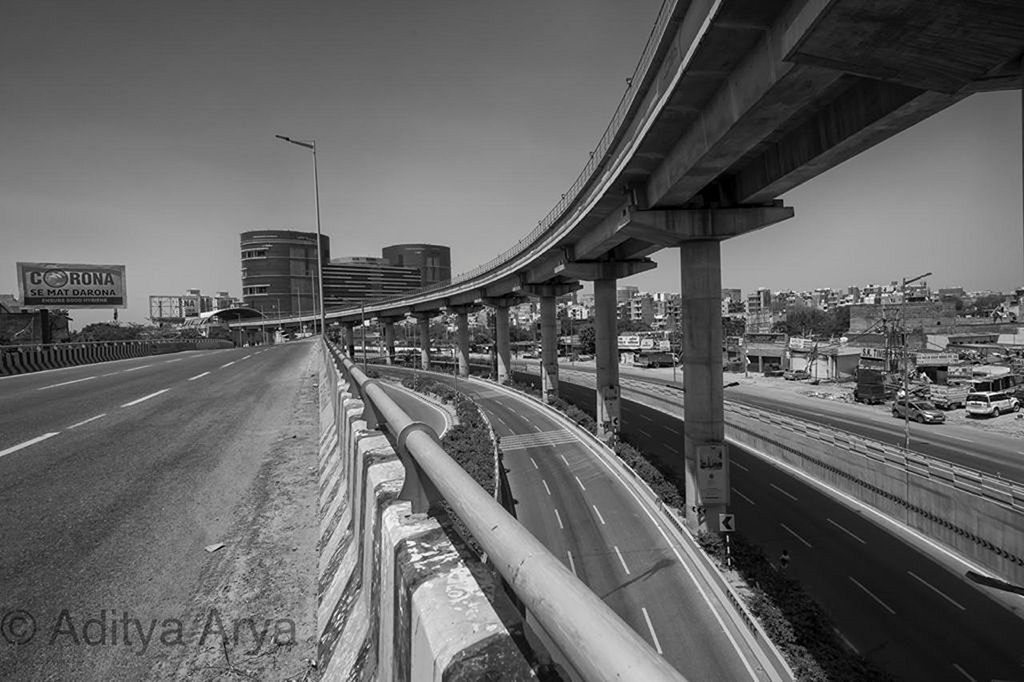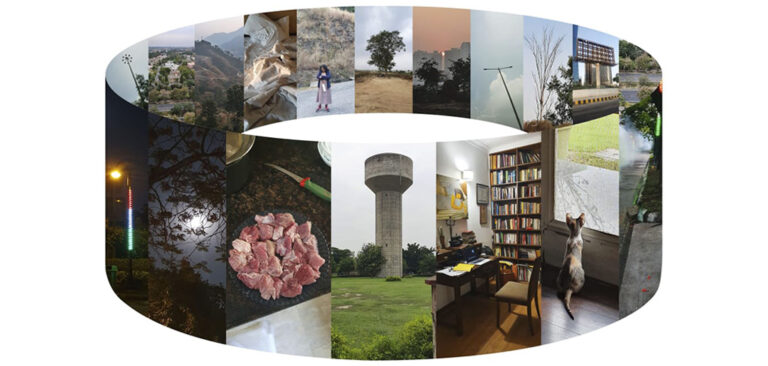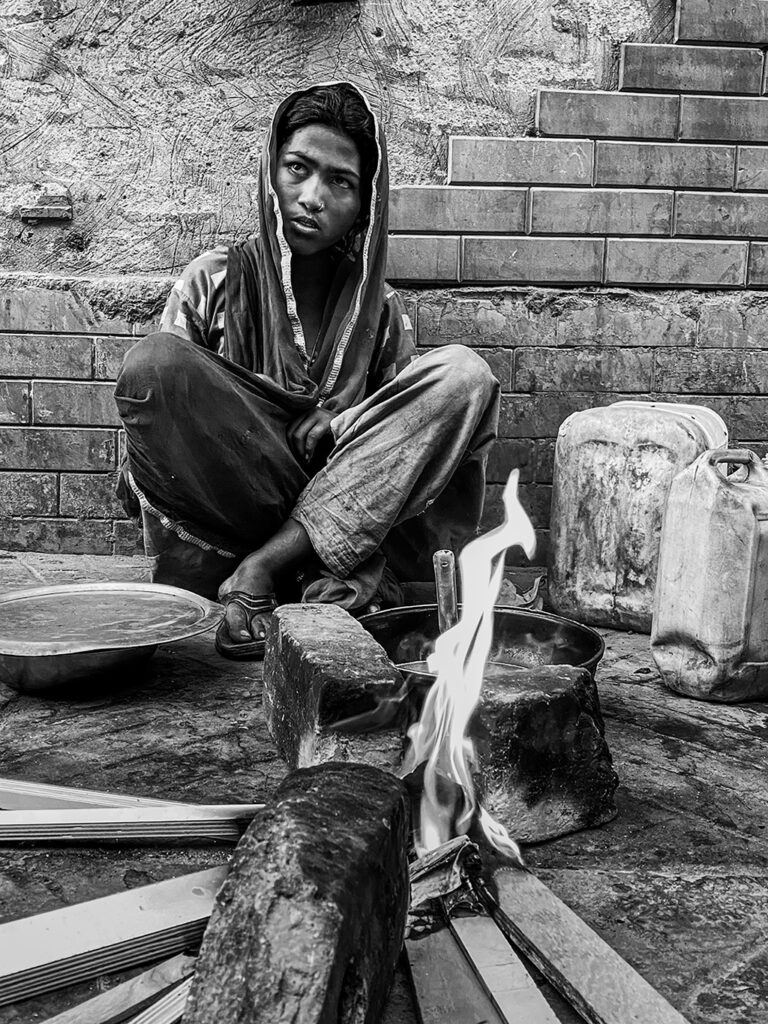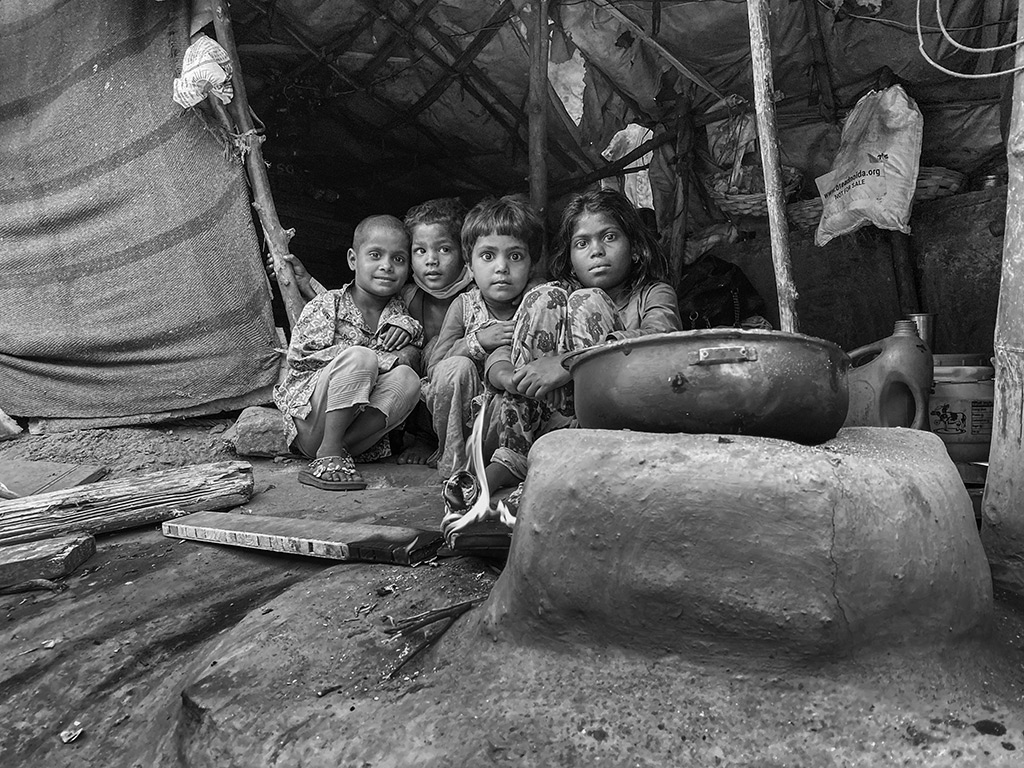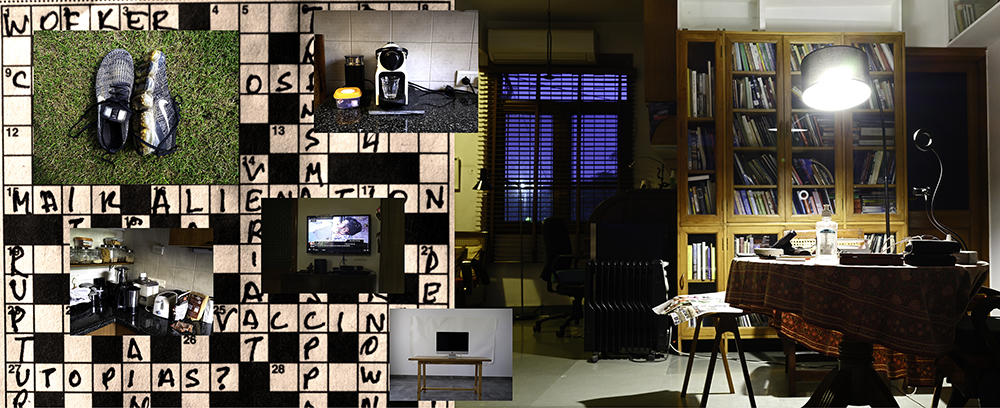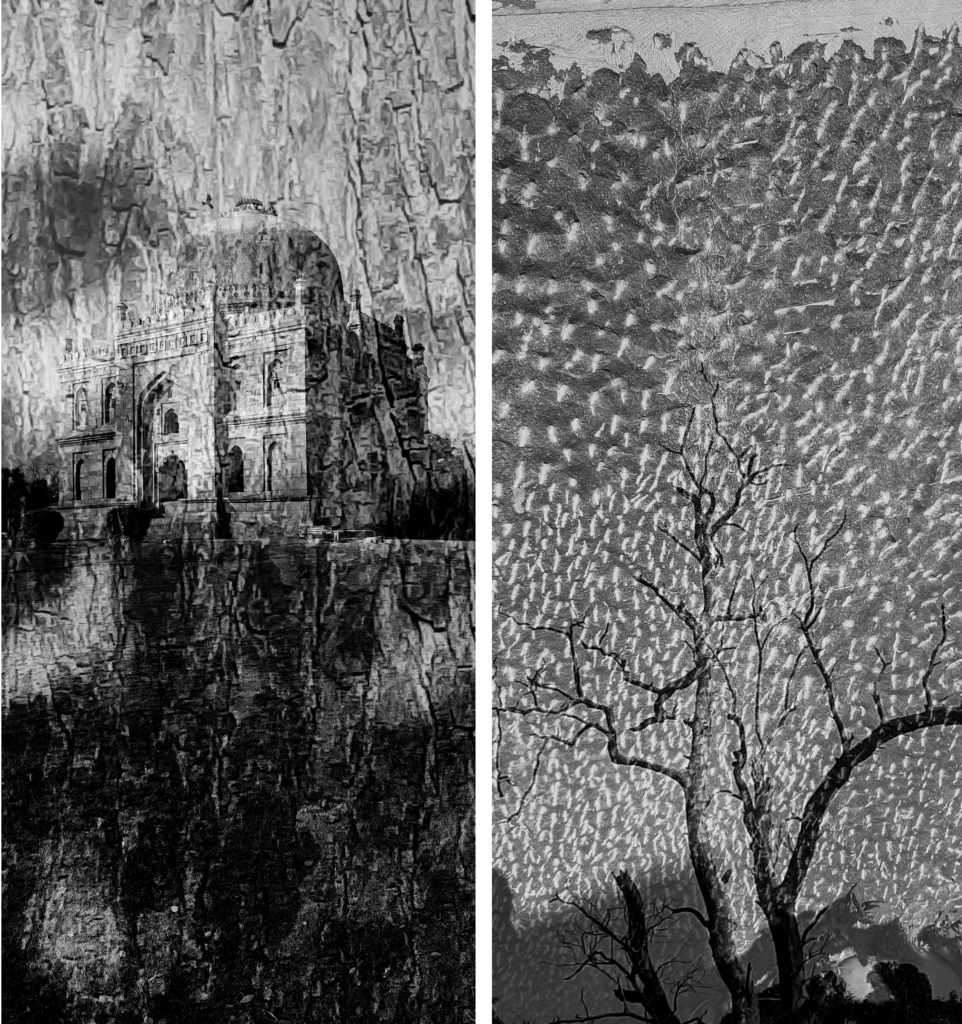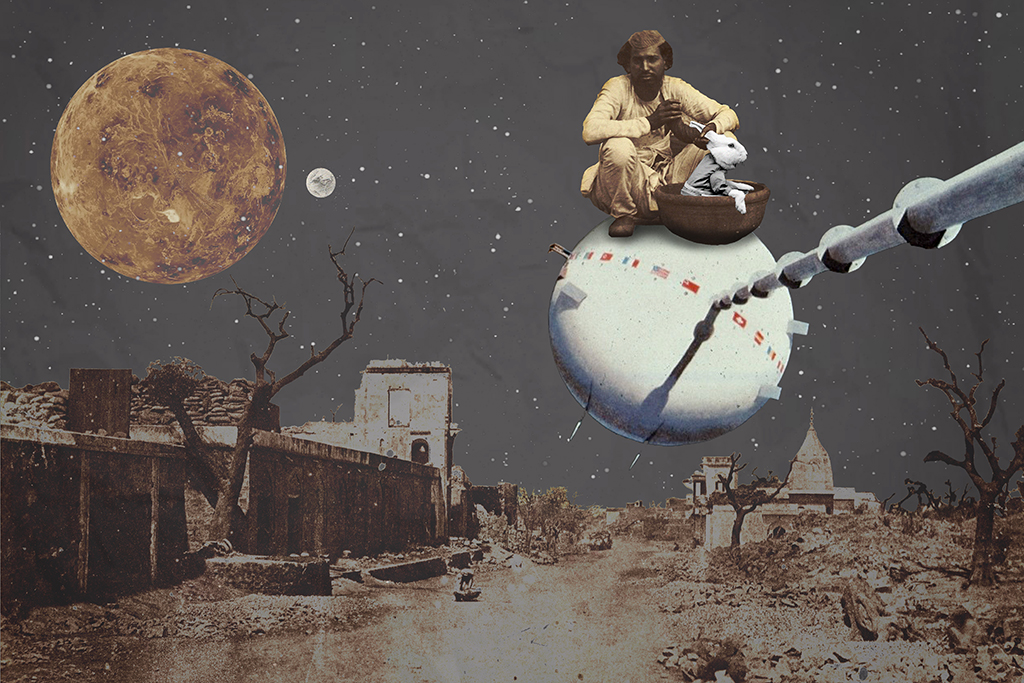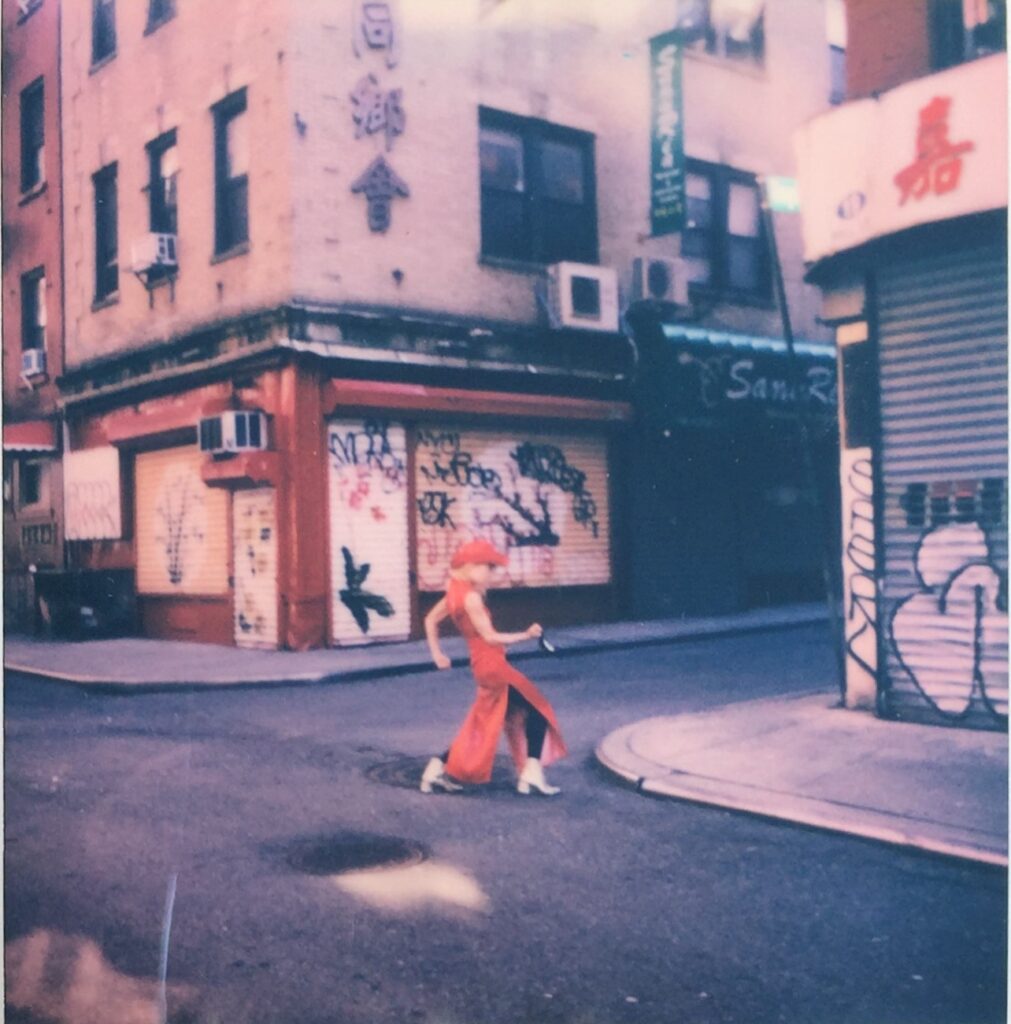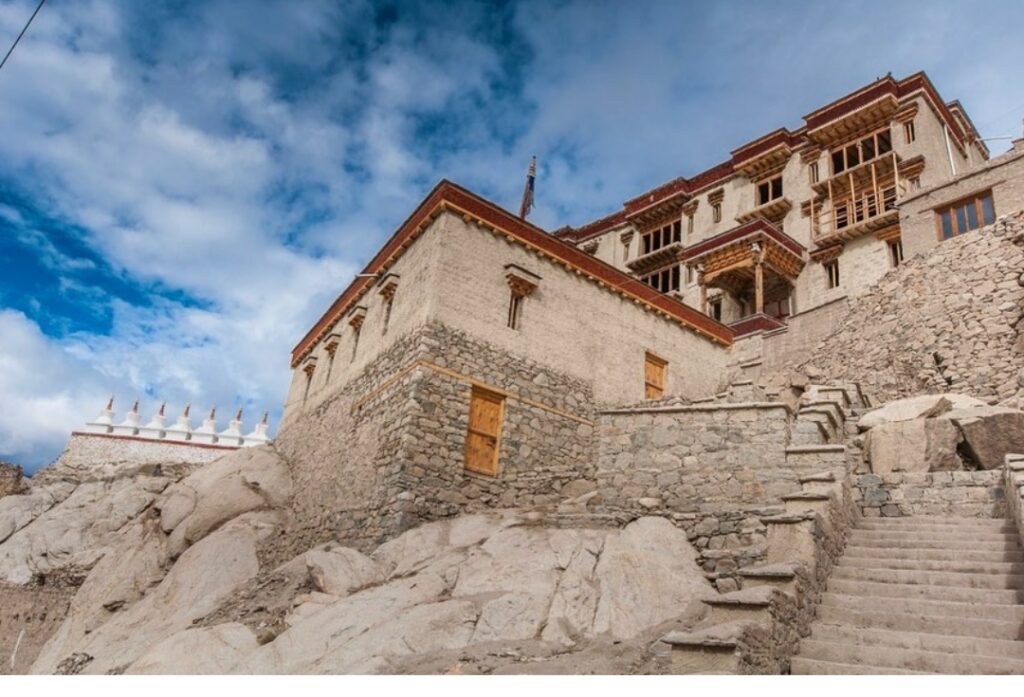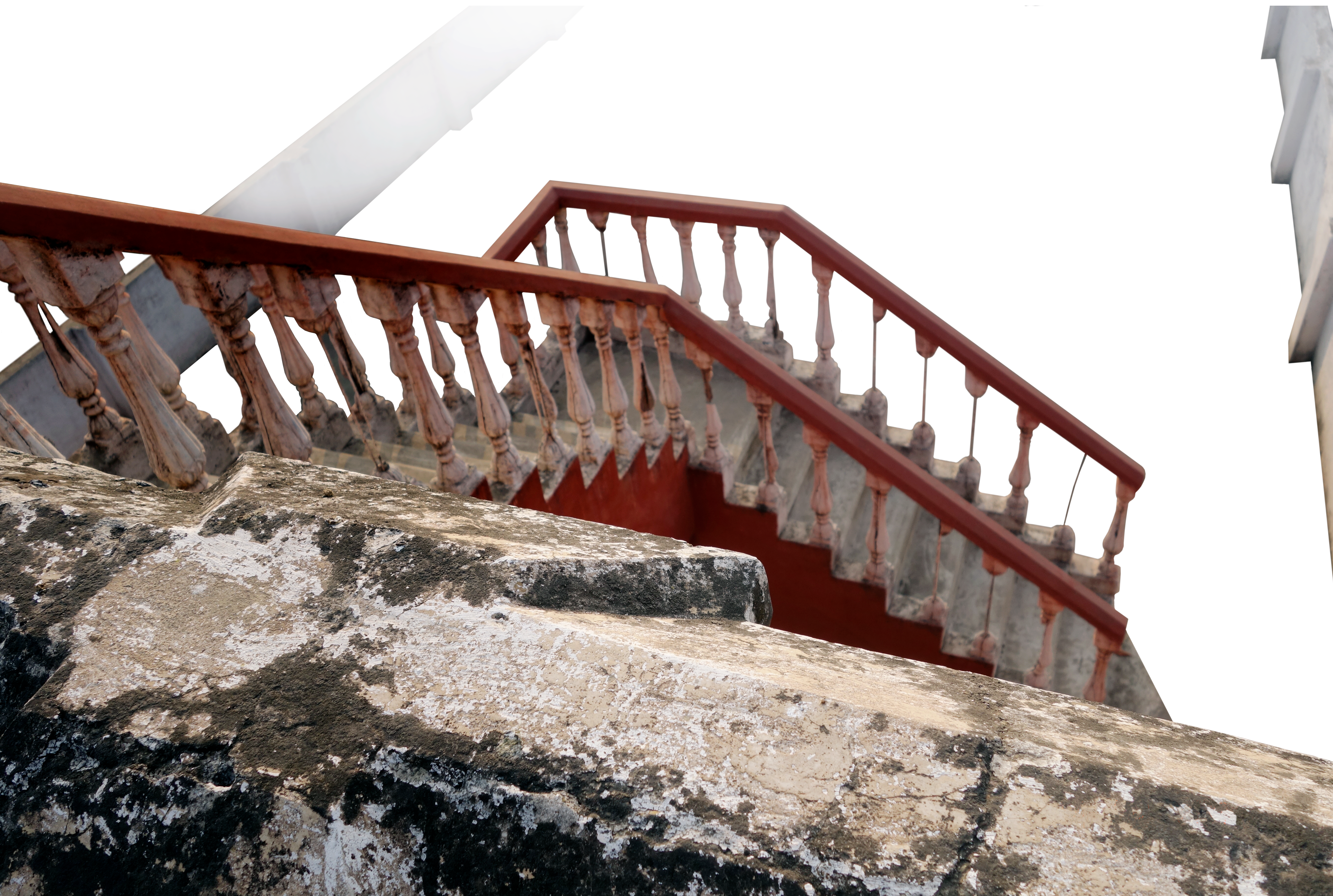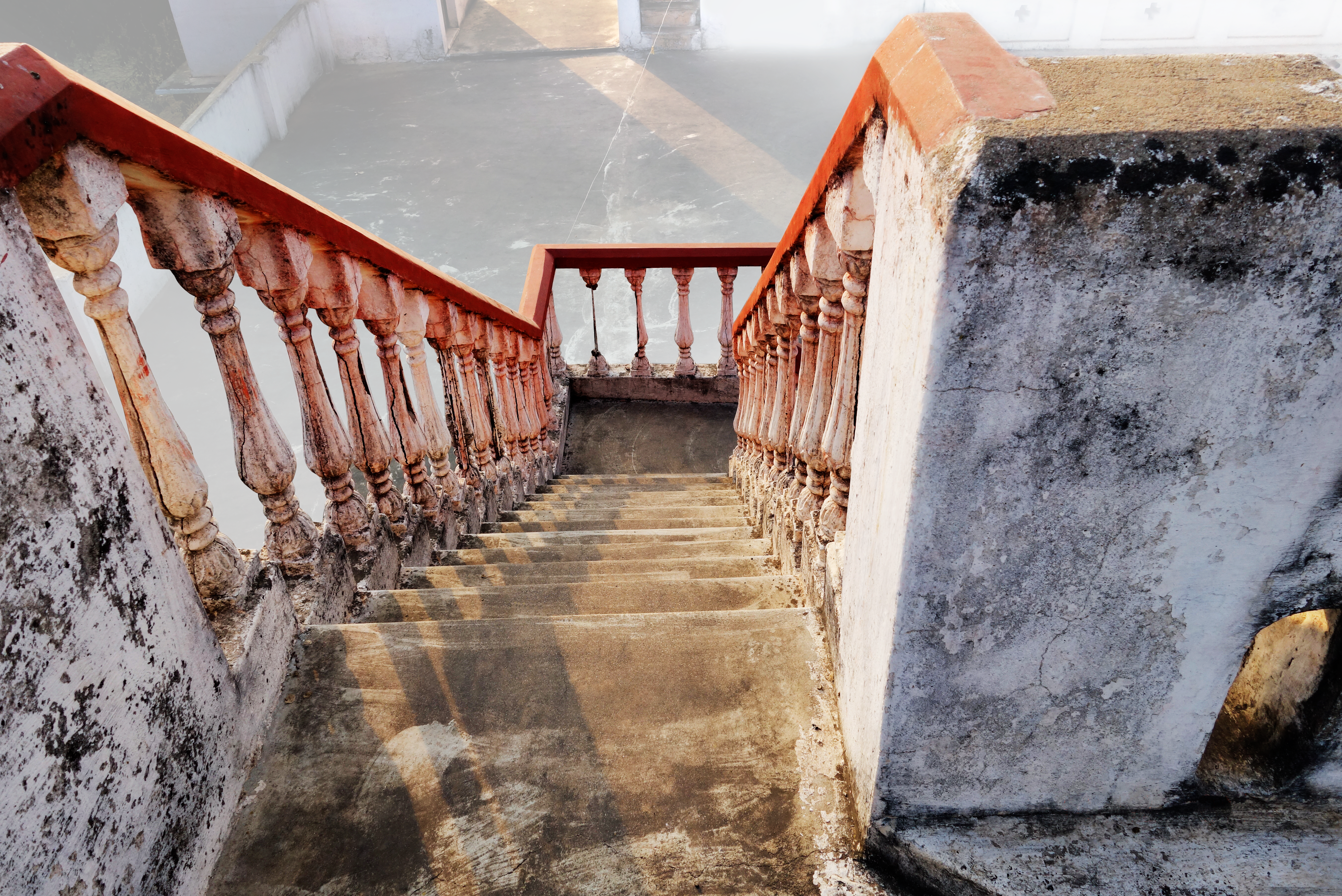If these walls could talk, they would tell us about the history of their past…
If the ceilings looking down upon the people within the structures,
could tell us about the lives played-out beneath their protective arches…
If the staircase that leads mysteriously to somewhere could guide us…
up or down to their final destination…
Then we could discover stories that perhaps have never been written down.
These open-ended narratives, these hidden secrets that lie buried within the edifice, the empty room with its hidden sense of abandoned glory and its past. This is what one hopes to tease out from within the corners of a room and bring them to the center of these constructed imagery, by artists who have witnessed and borne the COVID 19 pandemic and withstood the lockdown, with their cameras and sketchbooks being on ready to record and document the spectral almost eerie scenes unfolding with a sense of heightened empathy and a sense of stark poetry. One may witness a fascination with staircases and empty rooms within these works that are mainly photographic works but also digitally manipulated, photomontage and even drawings and paintings that take this narrative to a new hyper-realistic rendition. The absence of the human figure renders the metropolitan city of Delhi and its surrounding areas with a sense of irony. The city is cloaked in its vast history, with its past that is Mughal, Colonial and Modern is an important marker in urban history.
While the lockdown of the first wave had a gentle poetry to it, the deserted roads and shuttered shops now stand quietly as witnesses to the horror of the devastating second wave. The Pandemic has left the world ravaged, but one may also touch upon personal narrative and memory during these difficult times.
Curator Georgina Maddox
Aditya Arya
While photographer Aditya Arya trains his lens on the soaring towers of Gurgaon like the DLF Gateway Tower and the serpentine flyovers that connect the silicon city to NCR, he adeptly captures the empty motorways and the completely bizarre feel of a ghost town. One may draw parallels with his experiences with the high-rises of Vancouver where he spent time in his youth and captured the midnight sun and the sleeping city, since the city did not experience darkness until after 11.30 PM at night.
ADITYA ARYA an eminent commercial and travel photographer, Aditya Arya began professional photography in 1980 after graduating in History from the St. Stephen’s College, Delhi University. He wears Many Hats and has been a still photographer in the film industry in early eighties. After a brief stint in the Mumbai Film Industry, he moved back to Delhi.
Over the last few years, he has been completely immersed in the subject and practice of photographic conservation.He has honed his skills and knowledge on preservation, restoration and archiving. He has played a pivotal role in the establishment of the India Photo Archive Foundation and the Neel Dongre Awards/Grants for Excellence in Photography.
At present, he divides his time between his photography archive and Museo Camera which iis the largest not-for-profit photography museum in South-East Asia. A unique partnership between India Photo Archive Foundation and The Municipal Corporation of Gurugram, Museo Camera is one of a kind in India with 18,000 sq. ft. of space dedicated to the art and history of photography. With more than 2000 rare and iconic cameras and other equipment, this museum traces the history of photography from the 1870s to the Digital Era.
He was a guest faculty at Sri Aurobindo Centre of Art and Communication and also previously at the Jamia Millia Islamia University’s Institute of Mass Communication. He was also a mentor at Habitat Photosphere, a photography festival initiative by Visual Arts Gallery, India Habitat Centre.
Gigi Scaria
Gigi Scaria presents his visual almanac, his take on the cyclical nature of life, referencing technology and the phone imagery that has kept track of his life. Scaria ’s interest in urban topographies and city structures is something that has characterized his works for years now. He comments on how in his work the momentum provided by artistic and political traditions of his hometown Kerala is processed through the distinct invitation that Delhi offers to an artist of the city.
Gigi Scaria (B 1973), completed a Bachelor of Fine Arts degree at the College of Fine Arts, Thiruvananthapuram in 1995. Scaria moved to New Delhi where he undertook a Master of Arts at Jamia Millia Islamia. By 2000, increased international exposure was accompanied by prestigious residency opportunities and solo exhibitions in India, Germany, America, Hungary, the Republic of Korea and the Republic of Trinidad and Tobago. In 2002, Scaria was awarded an Inlaks Scholarship, and was artist-in-residence at UNIDEE, Cittadellarte- Pistoletto Foundation, Italy. Scaria’s creative repertoire includes painting, photography, installation, sculpture, and video.
Scaria’s first project for an American museum, Gigi Scaria: City Unclaimed was held in 2013 at the Smart Museum of Art, the University of Chicago. In 2010 Scaria participated in West Heavens, the first major artistic engagement between India and China. The exhibition Place time play: India-China contemporary art, was displayed at various venues by the Shanghai International Culture Association, China.
In 2011 The following year Scaria was one of five artists to represent India at the 54th Venice Biennale in the exhibition Everyone agrees: it’s about to explode, curated by Ranjit Hoskote. Scaria exhibited a major installation, Elevator. He also presented work at the 3rd Singapore Biennale as well as in Crossroads: India Escalate for the Prague Biennale.
His work also appeared in Critical Mass at the Tel Aviv Museum of Art, the first major exhibition to introduce contemporary Indian art to the Israeli public. Gigi Scaria was a 2012 University of Melbourne Macgeorge Fellow, and presented an exhibition of video works at the Ian Potter Museum of Art as part of the Melbourne Festival.
In 2014 Scaria participated in the Kochi Muziris Biennale titled Whorled Explorations curated by Jitish Kallat. In 2015 his next major solo exhibition took place in Gallery Chemould, Mumbai titled “The Ark”. In 2016 he exhibited a large-scale steel sculpture at Laumeier Sculpture Park, St. Louis, USA, and a solo exhibition “Time” at their art center. In 2017 his solo exhibition was held at Aicon Gallery, New York. He also held an exhibition of selected works titled Iconic Interruptions on Mahatma Gandhi, held at Frederic Jameson Gallery, Duke University in September 2017. Ecce Homo: Behold the man, a solo at Vadehra Art Gallery, New Delhi in 2018.
Parul Sharma
Parul Sharma a veteran media person for several years working with broadcast and television, has recently donned an avatar of artist-photographer and is totally self-taught. With her keen eye, in a span of three years of her photography, the Delhi based lens-woman has won critical acclaim for producing a large and diverse body of work. Her book of black and white photography “Dialects of Silence” of Delhi under lockdown was published and released by Roli Books in 2020 and has received acclaim from the curatorial team to present a selection of her work from this series that defines her experience the lockdown and the hidden poetry of such imagery. While we followed the tragedy of Delhi’s migrants struggling to reach their villages, we forgot migrant families left to fend for themselves under flyovers and makeshift shelters. Their sunken eyes and anger reflected their fear of a seemingly hopeless future
In a span of three years of her photography, Delhi based, Parul Sharma has won critical acclaim for producing a large and diverse body of work.
Her métier blends architectural design, and human form in urban landscapes. Her works first debuted in July 2017 in a solo exhibition “Parulscape” at Delhi’s iconic Bikaner House.
Forbes magazine marked its 10th anniversary in India by inviting her to shoot ten photographs that captured change and freedom in a decade.
In December 2019, Florence’s public Art Center, the prestigious Museo Marino Marini, exhibited her images of Naga
Sadhus and Transgenders at Kumbh Mela, titled ‘Mystic India’, the two-week exhibition exposed Italian art lovers, to the fierce vibrancy and colours of devout Hindus.
Her book of black and white photography “Dialects of Silence” of Delhi under lockdown was published and released by Roli Books on September 1, 2020 and has received acclaim in India Today, The Hindu, Hindustan Times, Indian Express, Open, Conde Nast, Business Standard and BBC among others.
Her next book, due for release in 2021, commissioned by Roli Books is an essay on Mumbai’s historic Art Deco Colaba district.
Ravi Agarwal
Artist-Photographer Ravi Agarwal shares a visual diary, structured around the everyday, mundane objects that one often takes for granted. During the Pandemic lockdown, the pause on the diurnal grind and the luxury of time gave these objects an added significance and personality. Agarwal explores how these objects become small anchors of ones-self.
Ravi Agarwal has an interdisciplinary practice as an artist, photographer, environmental campaigner, writer and curator. His work explores key contemporary questions of ecology, society, urban space and capital. Photography has been a prime medium for him for over four decades, which has expanded over time to include video, public art, installations, and recently also printmaking. His key projects have long engagements for several years, and are often accompanied by published diaries and writings. His work has been shown widely including at the Yinchuan Biennial (2018), Kochi Biennial (2016), the Sharjah Biennial (2013), Documenta XI (2002) amongst others. He co-curated the Yamuna-Elbe project, Indo German twin city public art and ecology project (2011) and Embrace our Rivers an IndoEuropean project in Chennai (2018). He was the photography curator for the Serendipity Arts Festival (Goa, India, 2018, and 2019). He is also curating “New Natures’ ‘, a show to open at the Goethe Institute Mumbai, in January 2022. His work is in several private and public collections, and he regularly serves on several art juries and committees.
His practice has been written about extensively in publications such as Fotografie –Eine Analyse der Arbeiten von Ravi Agarwal (in Kulturelle Übersetzer, Cathrine Bublatzky, Germany 2018), Art Ecology Now, (Andrew Brown, Thames and Hudson, UK, 2014), Cities and Photography, (Jane Thorny, Routledge, 2013) and Third Text, (Dec 2014, ed. T.J Demos). The book Down and Out, laboring under globalization (OUP 2000), photographed by him, is part of visual anthropology curriculums. Ravi is also the founder director of the environmental NGO Toxics Link and has pioneered work in waste and chemicals in India.
Sandeep Biswas
Photographer Sandeep Biswas has created a series of multi exposed and sketchy photographic images that are a revisit to his observations and memories, formed during his youth of the city, which transform into faint fragments of certain personal visual experiences. Many such layers of memories and identities come from specific locations where he spent an important part of growing up as a child, and presently they have become a juxtaposition of his own past and present. He tries to identify everything with the same childlike excitement and enthusiasm, yet it does not feel the same and there is an underlying melancholy.
Sandeep Biswas is an Indian Photographer with over two decades of experience in Art, Commercial and Social Documentary Photography. Presently he is busy dividing his time between his photographic practice, and as a guest faculty with various Art, Photography and design institutes. His practice as a photographer has earned him a few prestigious Awards, Fellowships like the japan Foundation fellowship 2001, India Habitat Centre Fellowship for Photography 2005 and Ministry of Culture Senior Artist Fellowship 2017 and an artist in residence program in the USA in 2018.
He has had 7 solo exhibitions, over 50 group exhibitions, in various parts of the world. His works have been invited to be part of various international Art & Photography festivals. He has curated a few Photography and lens-based Art exhibitions for Art Galleries and Art Institutions, as well as has written on photography for a few Art Magazines in India. He has been part of various Art Projects raising the issue of Gender equality and Environmental concern.
Sandeep has been a photographer with UNICEF, ILO, JICA, WHO, World Bank and a few other organizations, done commercial photography for Advertising agencies and corporate clients, Editorial photography for ELLE, L’officiel and Interior & Design magazine over the years. His works have been featured with various prestigious Art, Photography and Design magazines and journals around the world including the USA, Japan & Sweden.
He has worked on a few important book projects on Polio Eradication in India for UNICEF, Bagh Block Printing for Craft Revival Trust, Living Traditions of Chhattisgarh with Dr Alka Pande and Ms Tullika Kedia for Must Art. He has conducted various lectures and workshops in India, China and the USA. He is an invited Curator with the International Media Centre for Photography, Video and Sound Arts VASA Project based in the USA. Sandeep recently founded the Grayscale Academy of Photography and Creative Vision
Sarah Kaushik
Sarah Kaushik creates satirical scenarios in reaction to the occurrences around her, using digital montage as a medium to build narratives and cope. She is known as The Big-Eyed-Collagist which is not just her mere stage name, it is an indeterminable identity to contradict the gender biased society, almost a rebellion. In this series she shares with us her take on the idea of cities, abandoned structures and the imagery of the proletariat taken from a bygone era.
Sarah Kaushik is currently based in The Netherlands pursuing a research Masters in Scenography. She studied design in India and pursued the multidimensionality of the discipline that gave her a lot of exposure to not only design but helped sensitize her to observe the heritage, culture, the stereotypes, socio-political aspects of the country and the community. She eventually began constantly questioning her own beliefs of the past and contradicted them to be able to understand them better.
She uses vintage imagery from India and beyond to create scenarios of the current times. Her current practice, as a scenographer, allows her to constantly indulge in narratives and storytelling, the basis of every thematic exercise. She began working with digital montages, applying the same knowledge of building narratives, only in a two-dimensional space creating provocative juxtapositions to explore the concepts of Feminism, power, the country and the mysterious in single, yet powerful frames.
Her Online Avatar The Big-eyed Collagist is not just a mere stage name, it is an indeterminable identity to contradict the gender biased society, almost a rebellion. Her figures are dressed androgynously to transcend any gender expectations and stigmas attached to a specific gender.
These unexpected compositions address the boundaries between various social, political and cultural stigmas concerning our society, eventually hoping to achieve a tolerance for this complexity and diversity. The vintage finds are like chancing upon a rare gem in a forest – beautiful and priceless, holding stories within themselves, frozen in time and space. The color tones of vintage images, the slight blurry-ness and grains add a lot of texture and depth to an otherwise two-dimensional graphic.
Sarah has worked at the Rajiv Sethi Foundation for the Arts and found resonance with fashion label Papa Don’t Preach, the Lemon Tree chain of hotels, and most recently, Pali Hill in the UK, a newly-opened restaurant by Azure Hospitality the team behind Mamagoto and Sly Granny.
Sarah Singh
Sarah Singh shares with us how she shot all over the city when almost no one was venturing out; when the streets felt abandoned; shops were boarded up; The focus of the work is a woman who is constantly reinventing herself through gender, fashion, locations; as a means of liberation, as survival, and as a means of visibility at a time when everyone “disappeared”. A statement of strength and “I am still here” when the day to day felt increasingly unknown. The Polaroid medium has a fleeting, unpredictable nature which perfectly aligned with the time. Singh made this work with dancer and performer Robin Cofer during the lockdown of 2020 and this is the first time that it has been exhibited.
Sarah Singh is an award-winning artist/filmmaker who lives between the US and India. Her work has been invited across the world to museums, galleries, think tanks, universities, film festivals, and cultural organizations. Director of two feature films and numerous short films, Sarah is in development on her third feature which is a stylized western set in Europe. Sarah is the Founder-Director of Panorama Editions– a contemporary arts forum A contemporary black and white surrealist film work exploring Bertolt Brechts’ distancing effect ‘and the notion of expanded cinema. This film radically reinvents the geo-political narrative through themes of fragmentation, identity, loss, fantasy, secrecy and desire. Award winning director Sarah Singh continues to delve deep into the South Asian contemporary story.
Shalini Passi
Another self – taught photographer, collector art aficionado Shalini Passi engages with her spontaneity. This lockdown she shared with the artworld Forever Delhi: A series of black and white photographs, that capture and keep alive the city where she grew up, was educated in and began to love art. For this exhibition we present a selection of her works from Leh-Ladakh, where she recently travelled capturing the life of these living in already isolated conditions where the hub-bub of the city is virtually absent.
Shalini Passi is founder of The Shalini Passi Art Foundation & MASH. She is an Indian Art and Design collector, Art, Design and Fashion Patron, philanthropist, Art Advisor and an Artist based in New Delhi. Passi is the Creative Director of Pasco group of companies. Passi held a well-received exhibition entitled ‘The Warp and Weft of Perception’ and a solo art exhibition of paintings titled “Through my Eyes” at the Visual Arts Gallery in New Delhi. She also recently held an online exhibition of her black-and-white photography entitled ‘Forever Delhi’, 2020-21 as a fund-raiser for the COVID 19 Relief Fund.
Shivani Aggarwal
Shivani Agarwal has used photographic image, canvases and paperwork upon which she has both drawn and stitched. The many days of physical, social distancing and isolation enlarged her feelings of being confined. She became more sensitive to the small spaces in her house that are vacant and unnoticed, the little corners, the forms they create, the forms she sees and can create in those spaces. The four walls and their intersections have led her to create these stitched white and grey forms. The city seems to confine us as well into its large buildings and spaces. The work is about these uncomfortable confined spaces and ones compromises with them.
Shivani Aggarwal (B 1975.) is a New Delhi based Visual Artist. She has a Post Graduate Certificate in painting from Wimbledon School of Art (London, UK) where she was studying under Charles Wallace Art Award in 2003 and a Bachelor’s degree in fine arts from College of Art New Delhi 1996. Her art practice is an exploration of issues of gender and the human condition, drawing a connection between the society and its effects. She is invested in a variety of media to do with thread and fiber like sewing, weaving, crocheting, painting along with sculpture in wood, fiberglass with threads and video work, for the past 15 years. She has had five solo exhibitions in cities like London, Lahore, Mumbai and Delhi along with a solo project at the India Art Fair in 2013 with Studio Art Gallery New Delhi. She has widely exhibited her works in India and other countries like Singapore, Dubai, Germany, Belgium, England and Australia now. Her 2021 participation has been in Perth Australia in a show called ‘In situ’ at Holmes’a court gallery part of the Indian Ocean Craft Triennial. Her works are in various prestigious private collections in India and abroad. She is widely written
about in prestigious international magazines like ‘Sculpture’ and in various other esteemed platforms, magazines and newspapers.
Shruti Gupta Chandra
For artist-photographer and danseuse Shruti Gupta Chandra, photography is not a new art form she bought her first camera, a second-hand Canon A1 with her scholarship money in the late 1990 has been photographing since. She is known to hold long dialogues with stones and staircases rooftops and empty rooms of heritage structures especially that speak to her of past, where people have lived an left their past. Story of how they laughed or cried, how they lived a whole life…these are now empty spaces trodden mostly by strangers, shared the artist speaking of her slightly dark undertones of the picturesque imagery that is presented before us.
Artist Shruti Gupta Chandra did her initial artistic training under leading artist, Rameshwar Broota at the Triveni Kala Sangam, New Delhi in the early 1990s and then went on to establish herself, as an independent artist, with exhibitions at Exhibitions of Lalit Kala Akademi from 1990 to 2005. She received a Junior Fellowship by Government of India in 1991, National award by the Lalit Kala Akademi in 1991, the AIFACS award in 1995, the Taj Gaurav award in 2008 and most recent. The PHD Chambers of Commerce for painting in 2019. Shruti was selected to participate in the Indian section at the Jerusalem Biennale, Jerusalem in 2018. She also participated in the ‘Indian Panorama’, in Bangkok in 2017. Her works were part of a Collateral group exhibition at Kochi-Muziris Biennale in 2014-15. Shruti’s artworks are in the collection of the National Gallery of Modern Art, New Delhi, Delhi College of Art, Sahitya Kala Parishad, New Delhi and with a number of collectors in India and abroad. Shruti is also an accomplished Kathak dancer and has performed extensively all over the world. Shruti lives and works in New Delhi.
Vikram Singh
Vikram Singh has been making images for nearly two decades. Instinctive and spontaneous in his expression, he keeps his process simple. Confinement was a series that developed organically in response to the changed scenario in the pandemic. To express and document what he was feeling in visual form was imperative for his psychological well-being. A graduate of the University of Lincoln, he also has extensive experience in Film and video.
A glimpse unravels us into the complex worlds of all these artist-photographers through their imagery and insights into the Pandemic and its impact on humanity through self-reflexive artistic lens.
Vikram Singh has been making images for nearly two decades. His artistic expression is instinctive and spontaneous and he keeps the process simple. Confinement was a series that developed organically in response to the changed scenario in the pandemic. To express and document what he was feeling in visual form was imperative for his psychological well-being. A graduate of the University of Lincoln, he also has extensive experience in Film and video.
HOW TO BUY ARTWORK
- Select the artwork
- Share the LOT number with us
- Request for a payment link and make payment through all credit & debit cards, net banking, Paytm & UPI

- We can ship it to your address- For overseas purchases and purchases in India shipping costs will be added as per actuals.
Team Artspeaks India
WhatsApp – +91 93542 91990
To call and enquire – +91 98101 29873
You can also email us at – artspeaksindia2@gmail.com


